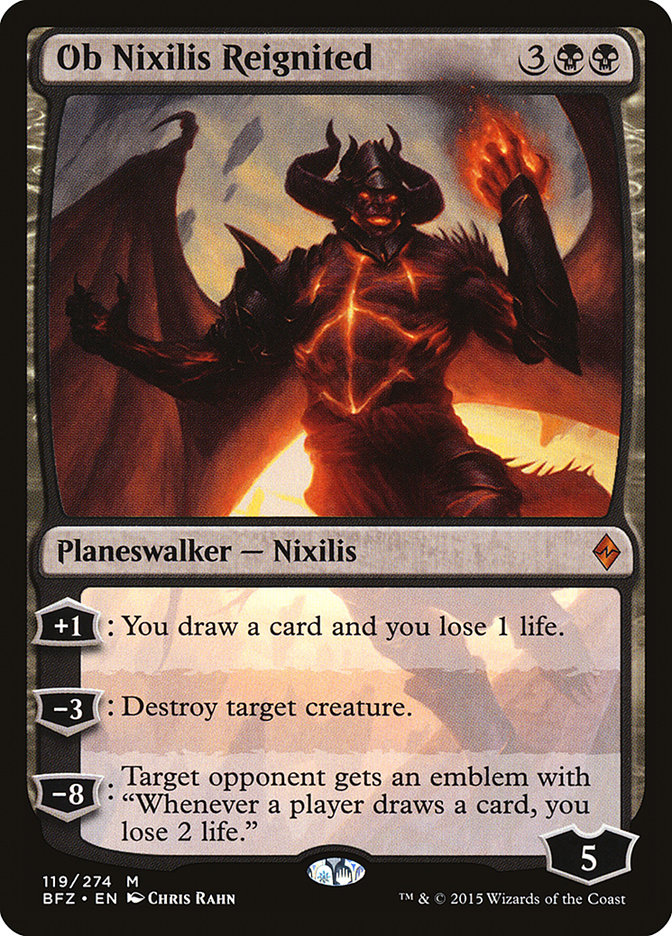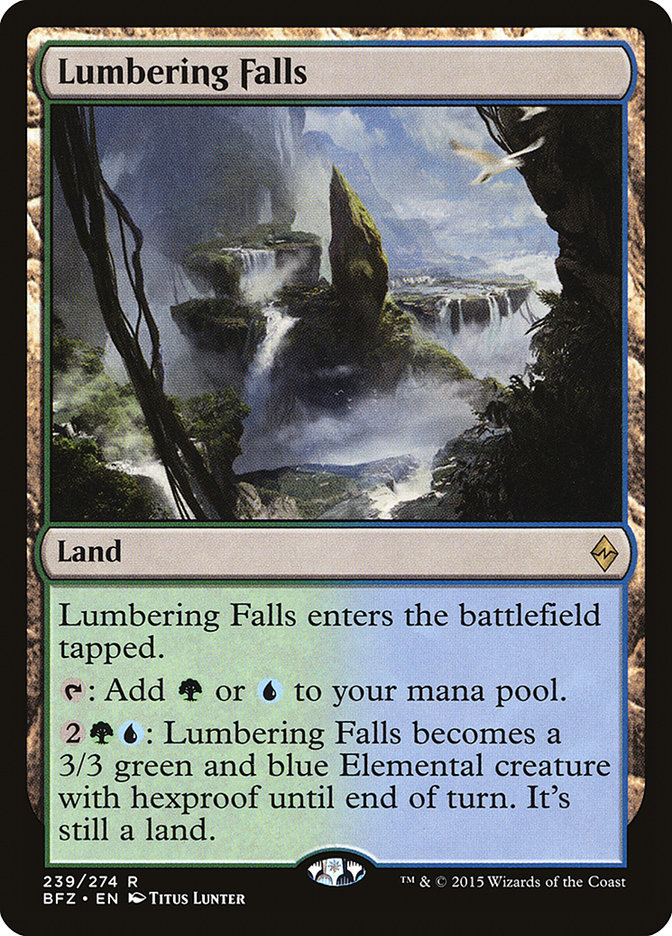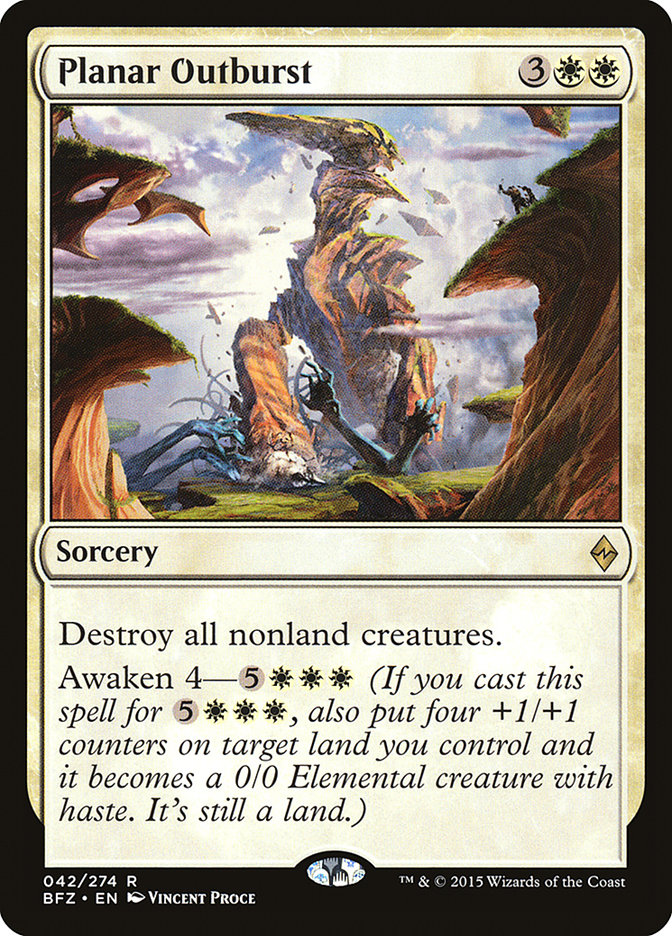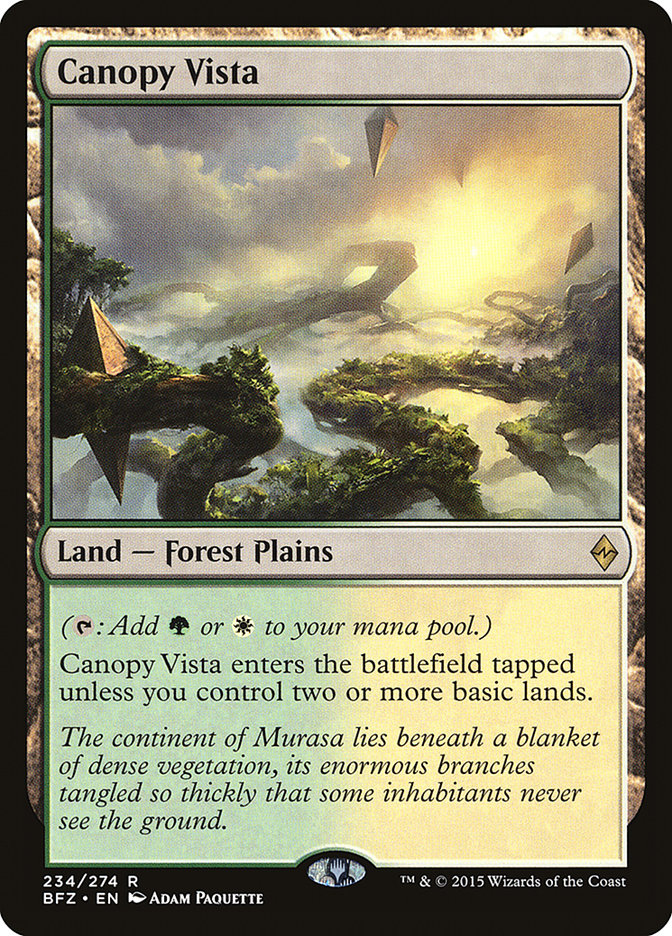There’s about to be a huge shift in the balance of power in Standard.
You know how many planeswalkers are going to rotate out when Battle for Zendikar comes online?
Eleven.
That’s ridiculous. It’s not even funny.
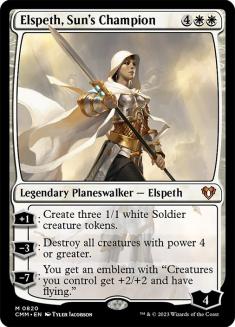
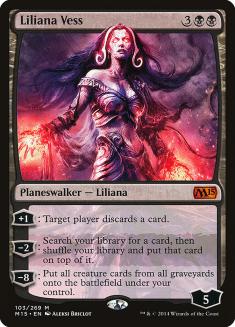
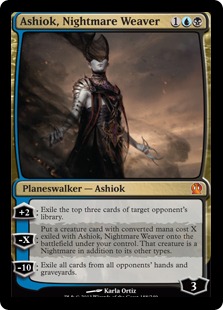
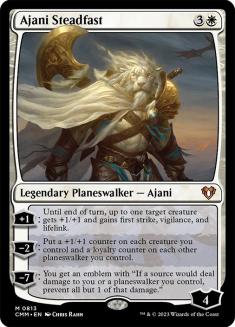
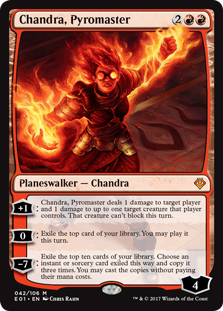

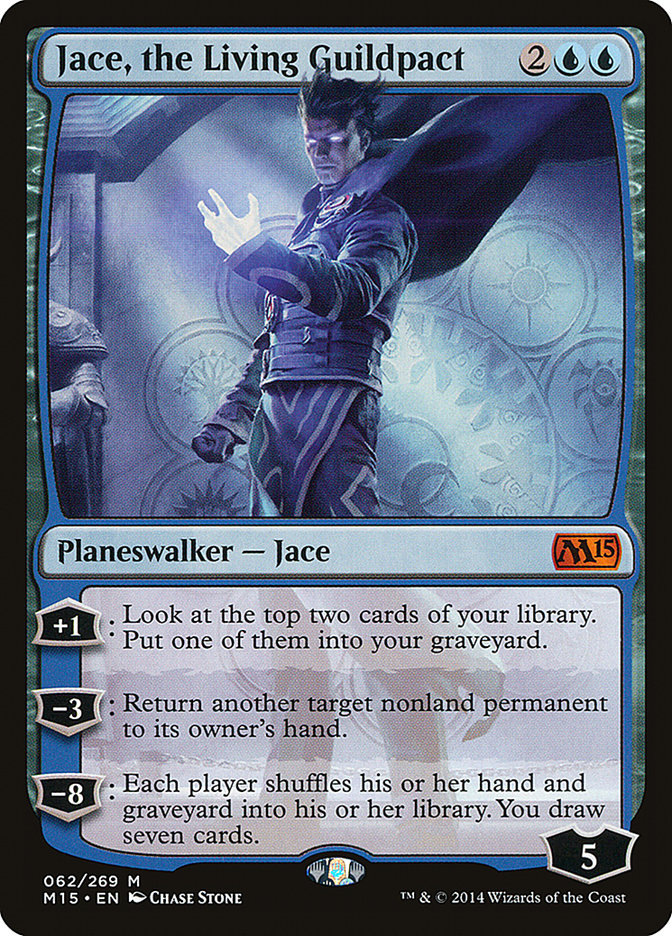
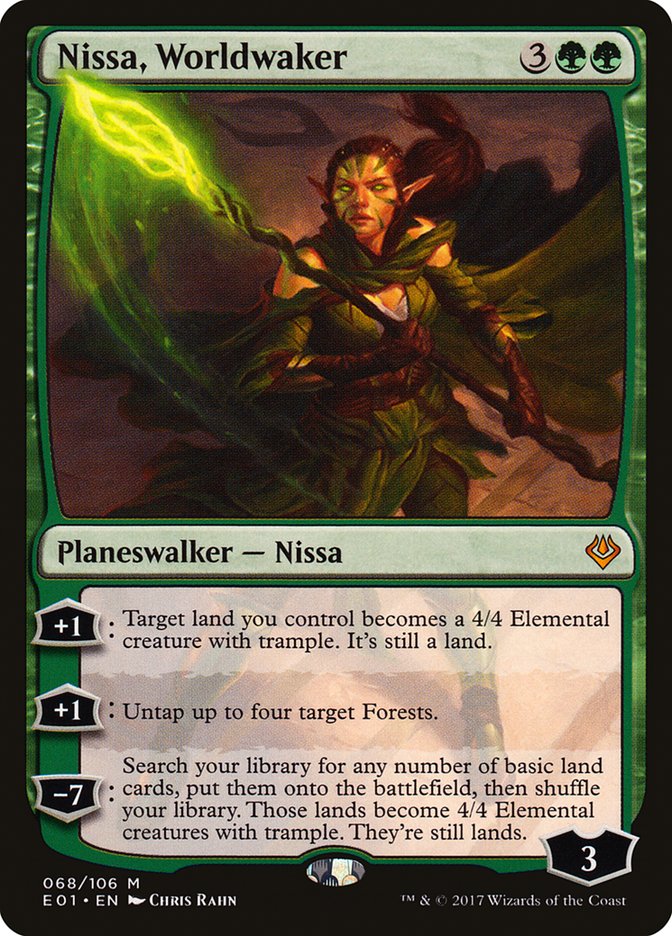
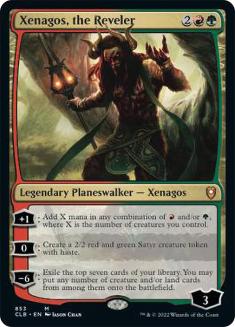
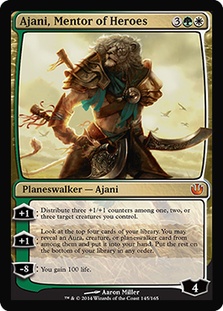
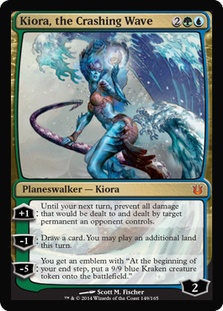
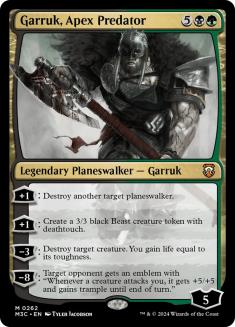

Battle for Zendikar
is not without planeswalkers of its own, but they have some seriously big shoes to fill (and there won’t even be half as many new ‘walkers coming in as
leaving). We already were introduced to a planeswalker so powerful, I am confident picking it as the best ‘walker in the set without even seeing the rest.
A thorough breakdown on Gideon, Ally of Zendikar can be found here.
However, it doesn’t stop there. Today, I’d like to start by taking a look at another planeswalker that will be a Standard staple.
What’s the easiest way to tell that Ob Nixilis will be a Standard staple? Luis Scott-Vargas previewed him. From the guy who previewed Siege Rhino,
Bonfire of the Damned, and Thragtusk, we have a five-cost planeswalker that draws cards, kills creatures, and has a legit ultimate that comes online after
just three turns. As if this wasn’t enough, opponents are going to be less easily able to remove ‘walkers, with Banishing Light rotating out and Hero’s
Downfall replaced with Ruinous Path. Besides, the format is just going to be less aggressive with five sets, rather than eight.
Ob Nixilis’s +1 ability finally gives black a replacement for the Underworld Connections they lost a year ago. Underworld Connections may “cost” three, but
it also costs one to use each turn, making it functionally cost four the turn you play it. Additionally, each turn you want to use it, it costs you another
mana.
By contrast, Ob Nixilis costs zero to use and gains you a loyalty each turn. Gaining a loyalty is often worth roughly something like a mana. It often costs
people a mana to do a damage to you, and when using Ob Nixilis’s -3 ability, it is like you are buying a Murder (without having to pay for it).
On rate, Ob Nixilis is close with just the +1 ability alone. If it cost four, it would be better than Underworld Connections, and that was a powerful card.
It can be attacked, but costing zero each turn is a big deal. Besides, going up to six loyalty is so much! That Ob Nixilis costs five (which is a big jump
in what we ask out of a card) means we’re going to need at least one more option we want to use sometimes.
Fortunately, Ob Nixilis’s -3 ability is basically the perfect complement to a card draw ability. Cards with multiple modes are not just a rate question
(how efficient they are); there’s also a question of how big of a range of utility they have. When a card has multiple modes you would want to use at the
same time, you are wasting some of the power.
When would you not want to pay a life to draw a card? Well, one of the single most common places would be when your opponent has a creature beating you
down! Ob Nixilis’s -3 ability isn’t just a five-mana kill spell. If it used all of his loyalty, then sure; however, you also end up with a planeswalker on
the battlefield that can draw a card each turn. For the most part, playing Ob Nixilis and using his -3 ability is kind of five-mana to kill a creature and
draw a card, and that card is a zero cost planeswalker. It may only have two loyalty on it, but it cost zero extra mana!
I think it will be a common play pattern to drop Ob Nixilis and kill the only creature on the table. Then, they drop another creature on their turn. Then
on your turn, you pay a life and draw a card, then use a kill spell on their creature. Then, maybe they drop two creatures on their next turn. Use a kill
spell on one, and cash in Ob Nixilis to kill the other.
You may have lost your ‘walker (one card), but you kill two creatures (costing them two cards and a lot of mana) and you drew a card (at a cost of just one
life). That is not just a three-for-one; it’s also a potentially big tempo swing. Besides, that’s just part of the range. Ob Nixilis is often at his best
when you can drop him, kill something, then just draw cards for a while.
Finally, we come to his ultimate. Ob Nixilis can -8 to give your opponent an emblem that functionally makes them lose at least four life a turn, that can
be speed up with all sorts of cards you’d play anyway (Treasure Cruise, Abzan Charm, etc) while also punishing the same out of them.
This isn’t the most important part of the puzzle, as Ob Nixilis is the type of card that might be burying your opponent in card advantage and creature kill
before the ultimate even matters, but it is nice to have that threat there changing the way your opponent has to play. It’s also nice that you only have to
plus him three times before you are threatening a play that many slow decks have little hope of overcoming (who are the exact people you might want to draw
three cards against without using the -3 ability?).
Let’s take a look at some decks that take advantage of Ob Nixilis:
Creatures (18)
- 1 Silumgar, the Drifting Death
- 1 Dragonlord Silumgar
- 4 Den Protector
- 2 Deathmist Raptor
- 4 Jace, Vryn's Prodigy
- 2 Nissa, Vastwood Seer
- 4 Hangarback Walker
Planeswalkers (5)
Lands (27)
Spells (10)

This Sultai list is probably pulled slightly too many ways, but it does include a lot of powerful cards and a lot of stuff worth trying.
Kiora Master of Depths is a four-cost ‘walker that draws a lot of cards. I’m in!
Like so many ‘walkers, her big appeal is her -2 ability, which gives you a creature and/or land from among your top four cards. That’s better than
drawing a card, but it does make her worse in decks that would normally be most in the market for a card like this. After all, she can’t hit most
removal spells, Dig Through Time, or other planeswalkers.
That ability is better than Anticipate, and that’s not even counting if you value dumping cards into your yard, but the ability to dump three cards in
your graveyard a turn means it has a much higher upside. Besides just fueling delve cards and finding Deathmist Raptors (or other recursive creatures),
it also increases our options for Den Protector and Haven of the Spirit Dragon (both of which she can actually find).
So, she’s often going to be a three-for-one since she’ll draw two cards outright the majority of the time, plus you still have a planeswalker on the
battlefield that is basically worth a card. You can cash it in for another card or two next turn, or you can use some of the other options.
As for the creature untap, you can get your creatures “vigilance,” which is particularly nice with Silumgar, the Drifting Death and Deathmist Raptor. You
can also abuse tap abilities. Creatures that tap for mana are one path, but this Sultai list features both Jace, Vryn’s Prodigy and Hangarback Walker for
mondo-combo action.
Each untap on Jace means another free loot. Jace is typically flipping eventually, and we’re actually going to get extra mileage out of Kiora’s self-mill
aspect. Even though she can’t keep a Ruinous Path or Dig Through Time, she can help find them for Jace!
As for Hangarback Walker, it may seem funny, but it’s actually pretty sweet to be able to gain two counters a turn. She even provides the mana you need to
do the extra activation since she gets to untap both a creature and a land at the same time.
Kiora’s ultimate takes four turns to get to (which means you’ve passed on tons of digging through your deck), but if you’ve got the game stabilized, it is
a reasonable way to close things out. In general, the added dimension it offers you isn’t going to matter that much, but it does put pressure on
people to act. It’s also nice to have something to work towards when your deck starts getting thin enough that you don’t want to self-mill anymore!
Note: Her emblem doesn’t go infinite with itself. The emblem just makes all your creatures fight. It doesn’t make tokens. The three tokens you get are
the other thing the ultimate does.
The unveiling of Lumbering Falls is a serious game-changer. First, setting aside the implications of more tier 1 duals, let’s just look at the card on its
own merits. Four mana to get a 3/3 with an ability is just like Raging Ravine (which was one of the best), but the ability is so radically different from
Raging Ravine’s, it’s hard to compare them.
Hexproof is a really, really desirable ability for a creature-land. It is really easy to imagine a deck that has no targets for removal spells using
Lumbering Falls alongside Silumgar, the Drifting Death and planeswalkers (perhaps with other creatures that all draw a card). Such a deck would regularly
arrive at a boardstate where the opponent has several removal spells in hand since they have nothing to use them on. Lumbering Falls is absolutely awesome
in spots like this.
Honestly, Lumbering Falls could have been smaller or more expensive and still easily worth playing since the opportunity cost is so low. However, it’s
actually quite efficient and a good distribution of power. This one is excellent.
As for the fallout from another powerful enemy dual? Well, there are going to be major ripples, but as if that wasn’t crazy enough, Mark Rosewater confirmed that the enemy
creature-lands are split between Battle for Zendikar and Oath of the Gatewatch!
The most obvious split is to put three in this set and two in the next (since this set is bigger); however, I think it really depends on what is in the
rest of both sets.
It kind of actually suggests to me that it would be more logical to put just two enemy creature-lands in this set since that would make it a seven to three
split for rare duals. Besides, I think you could really shake up the format if the only enemy creature-lands printed were U/G and R/W, at least for three
months.
If they were only doing two, it would be a bit weird and inefficient to have them touch (ruling out U/R and B/G). I also think it is less likely they
decided to print B/W as the second of two since they would surely have known by this point in development just how long Abzan has been really strong (and
Abzan would love a creature-land more than anyone).
If there are three, there are a lot more possibilities, but I would be shocked if the other two were B/G and B/W. My guess would be U/G, R/W, and
B/G since this only gives Abzan one, and a B/G creature-land will spawn more new archetypes than a B/W one. Besides, there is something pleasing about
having green be the color that doubles up since it is the land color.
Obviously, they could print the B/W one instead of the B/G, but I could also imagine them literally just skipping the two Abzan color combinations. The
thing is, if that was their plan, it seems more likely they would arrive at the two creature-lands in set one, three in set two plan.
Here’s a look at Abzan with Ob Nixilis, first without either possible creature-land:
Creatures (15)
Planeswalkers (7)
Lands (26)
Spells (12)

There is starting to become a glut at the five-spot on the curve since there is such an embarrassingly awesome set of options. Den Protector can be played
for two or three, but she often wants to be a five. Ob Nixilis is an excellent five that does all the stuff we want. So, can we really play five-cost
sweepers?
Planar Outburst is an upgrade over End Hostilities for the most part. There is no more bestow and equipment is pretty rare. It has the drawback of not
killing land creatures, but it has the bigger upside of not killing land creatures.
The most common place this comes up is with Awaken, which Planar Outburst has as an added bonus. On this card, it is functionally a kicker that lets you
pay an extra three mana to turn one of your lands into a creature. If you have nine mana, instead of eight, you can actually attack with the creature
immediately.
That may seem like a lot of mana, but the opportunity cost is extremely low. After all, we’ve been playing five-mana sweepers all year with nearly
no upside. Besides, Abzan is exactly the kind of deck that going long regularly gets up to eight and nine mana. Even without Courser of Kruphix, we still
have Nissa and plenty of card draw, like Abzan Charm and now Ob Nixilis.
Spending eight on Planar Outburst sometimes isn’t the same as playing Ugin since you also have the option of using it several turns earlier when you only
have five mana (while Ugin is just sitting in your hand, giving you no options). This doesn’t take away from Ugin’s goodness, it’s just a different sort of
play. Incidentally, Ugin works great with Awakened lands, since his –X ability doesn’t kill them.
One of the sweet parts of Planar Outburst is that it basically implies the path is cleared for your land to attack unblocked. This can be great for
finishing people off or trying to stop a planeswalker from ultimating. It is kind of sweet that if your opponent has an Ugin, you can go after it with 4/4
lands that neither of his abilities trump.
In addition to Planar Outburst, Ruinous Path gives us more ways to awaken our mana. It is conceivable that the 4/4 token helps hold down the ground, and
then when we Planar Outburst, we actually end up with two 4/4s sticking around.
All this sounds great, but I thought we had too many fives? What happened to Languish?
Good question. I guess my answer starts with Gideon, Ally of Zendikar. Gideon is an extremely powerful Magic card and playing four of it might just be too
good to pass up in a deck like this. If that is the case, we’re already at eight four-drops, which is a little higher than we’d like to begin with.
But you made room for an Utter End?
Okay, that’s a fair point and probably a leak on my part. Utter End does seem sweet, particularly as an extra answer to Hangarback Walker, but I guess it
might just make sense to cut the Utter End and the Tragic Arrogance for a Languish and another Ruinous Path. I just really like having a little instant
speed interaction. Besides, Languish also might just be a little weaker because of the nature of which cards survive the rotation. Besides, a lot
of opponents are going to have Gideon, Ally of Zendikar in their decks, and a single emblem radically changes the effectiveness of a Languish (think
Wingmate Roc and Anafenza, the Foremost).
The creatures and planeswalkers in this list are amazing, but we really do need more two-mana plays. I think as presented, this list is just too slow. I’m
not sure what that will end up looking like, but with almost no two-mana removal and no Thoughtseizes, I think we’re just asking to get run over by people
actually taking advantage of their first two turns. The number one thing I am going to be looking at for Abzan is another powerful and reliable two-mana
play.
The Battle lands are nowhere near fully understood, as so much of their power is tied up in having the land types, which requires more context. Even still,
it is clear they will have a profound impact with fetchlands. Windswept Heath being able to find Canopy Vista is a big deal, and in fact, we were able to
cut the second Plains from this list despite having Gideon, Ally of Zendikar we need to cast on turn 4 (sometimes off of two Windswept Heath). We can use
the two Heaths to find both Plains and Vista, making the mana work mostly smoothly.
It is important to note that Nissa, Vastwood Seer cannot search up Canopy Vista, as she explicitly only finds basic Forests. Interestingly, Knight of the
White Orchid does not have this restriction, meaning it can find both Canopy Vista and Prairie Stream.
Why not use more Canopy Vistas? They are better than the gain life lands, right?
Well yes, but they are only the allied color combinations, while the gain life lands give us more enemy duals. This list is already tight on black compared
to what we’d prefer. It does suck to have to use five gain life tapped duals, but if we get a creature-land to use, we’ve got a lot of options open to us.
For instance, here’s a look at a manabase we could build if there’s a B/G creature-land in this set:
4 G/B Creature-land
3 Forest
3 Swamp
2 Plains
Notice how this list has 27 land, as opposed to the above 26-land manabase. The printing of creature-lands gives us even more reason to play heavy on mana,
and this new breed of Abzan has even more expensive options it wants to play, without Coursers to help us hit or land drops in the midgame.
Here’s a build for if we live in the world where there’s a B/W creature-land but not a B/G one:
4 B/W Creature-land
3 Forest
2 Swamp
2 Plains
This one has better mana than the previous one since Nissa makes us need to play more Forests than we otherwise would want to, making other green duals
less valuable. Additionally, our Abzan deck uses lots of double white and lots of double black, but has so far avoided any double green. This makes B/W
duals particularly attractive.
What if the last duals are both Abzan colors?
That is probably not the world we live in, but if it turns out that it is, just use all eight unless one of them is surprisingly weak.
Looking at more Ob Nixilis decks, here’s a take on B/W Midrange:
Creatures (12)
Planeswalkers (6)
Lands (26)
Spells (16)

Of course, if there is a B/W creature-land, then by all means, replace the Sandsteppe Citadels with them!
That said, I can’t help but notice that if we replaced two Radiant Fountains, two Plains, and a Nomad Outpost with four Windswept Heaths and a Canopy
Vista, we’re up to nine sources of green already. It doesn’t take many of those Swamps becoming Llanowar Wastes (or creature-lands) to splash Siege Rhino…
Something I find really interesting about the uneven mix of new duals is how much it changes the color combinations we are encouraged to play. In
particular, the combination of Battle lands and fetchlands makes playing old school shards really easy. For instance, here’s a possible Esper build:
Creatures (7)
Planeswalkers (8)
Lands (27)
Spells (18)

I’m guessing there will be a better three-mana counter than Cancel (probably with Awaken or something), and assuming it’s pure upside, just swap them
one-for-one.
As for the mana, this list has eighteen blue, seventeen white, seventeen black, and will rarely have to play any of its lands tapped when it needs the
mana. This is particularly interesting to consider for three-color aggro decks in shard color combinations.
If there happens to be a B/W creature-land, maybe we would do something like this:
4 W/B Creatureland
2 Swamp
2 Plains
2 Island
It’s going to be really interesting finding out which enemy creature-land or two is still to come in this set, as the manabases that are possible has such
a huge impact on what kinds of decks we should be working on. The prospect of playing a three-color manabase that rarely plays lands tapped is extremely
enticing, even if they are three-color combinations without any of the amazing three-color cards from Khans block.
For instance, here is a possible Jund Midrange deck:
Creatures (20)
- 1 Tasigur, the Golden Fang
- 4 Den Protector
- 3 Deathmist Raptor
- 4 Nissa, Vastwood Seer
- 4 Abbot of Keral Keep
- 4 Hangarback Walker
Planeswalkers (2)
Lands (26)
Spells (12)

This list would absolutely love a G/B creature-land, of course, but even without, I love the idea of finding a Mountain on turn 1, to Wild Slash, then
finding a Forest or Swamp on turn 2 for Hangarback Walker, and then having all of our lands enter the battlefield untapped for the rest of the game!
It’s going to be interesting to see what other technology spawns out of the interaction between fetchlands and Battle lands, because we could also see some
really strange four and five-color manabases that would normally be too slow. It’s also going to be really interesting to see what the best landfall cards
are, because manabases with sixteen fetchlands seems possible, and that’s a lot of triggers…

